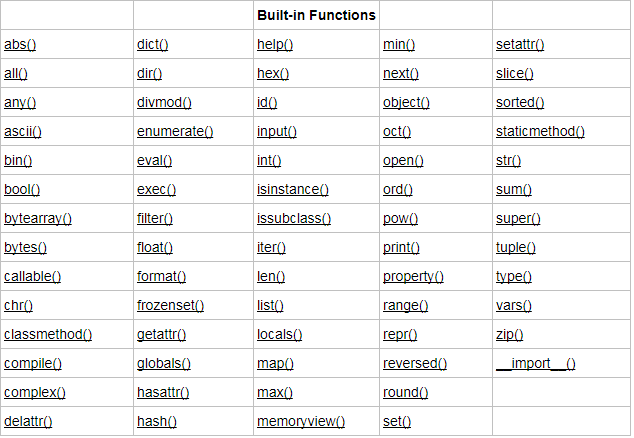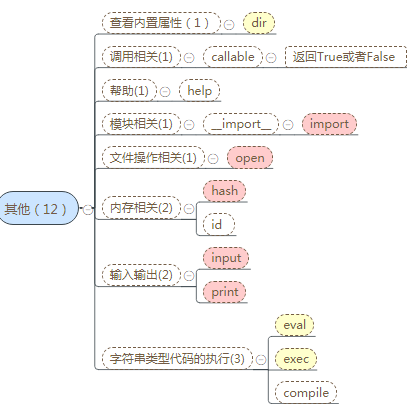
截止到python版本3.6.2,现在python一共为我们提供了68个内置函数。它们就是python提供给你直接可以拿来使用的所有函数。

一,作用域相关(2个)
基于字典的形式获取局部变量和全局变量
locals() #返回本地作用域中的所有名字
globals() #返回全局作用域中的所有名字
类似的变量
global 变量 全局变量
nonlocal 变量 局部变量与离他近的上层函数相关
二,迭代器/生成器相关(3个)
1, iter()
迭代器 = iter(可迭代的) #生成迭代器
迭代器 = 可迭代的.__iter__()
2 ,next()
迭代器.__next__() #调用迭代器
next(迭代器)
3,range()
range(10)
range(1,11)
print('__next__' in dir(range(1,11,2)))
三,其他(12个)

(1)查看内置属性 1
查看所有的内置函数
dir(__builtins__)
查看某对象的属性及方法
dir([1,2])
dir(list)
(2)和调用相关 1
callable(o),o是参数,看这个变量是不是可调用。
如果o是一个函数名,就会返回True
(3)输入输出相关 2
input()
print()

def print(self, *args, sep=' ', end=' ', file=None): # known special case of print """ print(value, ..., sep=' ', end=' ', file=sys.stdout, flush=False) file: 默认是输出到屏幕,如果设置为文件句柄,输出到文件 sep: 打印多个值之间的分隔符,默认为空格 end: 每一次打印的结尾,默认为换行符 flush: 立即把内容输出到流文件,不作缓存 """

import time for i in range(0,101,2): time.sleep(0.1) char_num = i//2 #打印多少个'*' per_str = ' %s%% : %s ' % (i, '*' * char_num) if i == 100 else ' %s%% : %s'%(i,'*'*char_num) print(per_str,end='', flush=True) #小越越 : 可以把光标移动到行首但不换行

l='a' print(l) #a print(l,end='%%') # a%% end是print中默认的以换行结尾,这里可以改为%%结尾 print(l,end='%%') #a%%a%% print(l,2,3,5,6,sep='%%') #a%%2%%3%%5%%6 sep是print中元素之间默认用空格隔开,这里可以改成%% print(l,2,3,5,6) #a 2 3 5 6 f=open('上课',mode='w',encoding='utf-8') #打开文件夹,之后通过句柄操作文件 l='mmmm' print(l,file=f) #print中file默认在控制台打印,可以把file=f文件句柄,改成在文件中打印 f.close() f = open('tmp_file','w') print(123,456,sep=',',file = f,flush=True)
(4)内存相关 2
id(o) o是参数,返回一个变量的内存地址
hash(o) o是参数,返回一个可hash变量的哈希值,不可hash的变量被hash之后会报错。
hash函数会根据一个内部的算法对当前可hash变量进行处理,返回一个int数字。
*每一次执行程序,内容相同的变量hash值在这一次执行过程中不会发生改变。
(5)数据类型相关 1
type(o) 返回变量o的数据类型
(6)模块操作相关 1
__import__导入一个模块

# import time # print(time.time()) #1515230362.92395 # 等同于以下例子 # t=__import__('time') # print(t.time()) #1515230362.92395
(7)帮助方法
在控制台执行help()进入帮助模式。可以随意输入变量或者变量的类型。输入q退出
或者直接执行help(o),o是参数,查看和变量o有关的操作。。。
(8)文件操作相关
open() 打开一个文件,返回一个文件操作符(文件句柄)
操作文件的模式有r,w,a,r+,w+,a+ 共6种,每一种方式都可以用二进制的形式操作(rb,wb,ab,rb+,wb+,ab+)
可以用encoding指定编码.
(9)字符串类型代码的执行
# exec和eval都可以执行 字符串类型的代码
# eval有返回值 —— 有结果的简单计算
# exec没有返回值 —— 简单流程控制
# eval只能用在你明确知道你要执行的代码是什么
eval() 将字符串类型的代码执行并返回结果
eval 把有意义的字符串执行 ,有返回值 # print(eval('1+2')) #3 eval('1+2') #什么也没有显示 # eval("print('美丽')") #美丽 # print(eval("print('美丽')")) #美丽 None # print(print('美丽')) #None
exec()将自字符串类型的代码执行
print(exec("1+2+3+4")) exec("print('hello,world')")
exec 把有意义的字符串执行,简单的流程控制,没有返回值
# exec('for i in range(5):print(i)') #0,1,2,3,4 不能用eval
# exec('print(1+2)') #3
# exec('1+2') # 什么也没有显示
# print(exec('1+2')) #None
# print(exec('print(1+2)'))
compile 将字符串类型的代码编译。代码对象能够通过exec语句来执行或者eval()进行求值

参数说明: 1. 参数source:字符串或者AST(Abstract Syntax Trees)对象。即需要动态执行的代码段。 2. 参数 filename:代码文件名称,如果不是从文件读取代码则传递一些可辨认的值。当传入了source参数时,filename参数传入空字符即可。 3. 参数model:指定编译代码的种类,可以指定为 ‘exec’,’eval’,’single’。当source中包含流程语句时,model应指定为‘exec’;当source中只包含一个简单的求值表达式,model应指定为‘eval’;当source中包含了交互式命令语句,model应指定为'single'。 复制代码 >>> #流程语句使用exec >>> code1 = 'for i in range(0,10): print (i)' >>> compile1 = compile(code1,'','exec') >>> exec (compile1) 1 3 5 7 9 >>> #简单求值表达式用eval >>> code2 = '1 + 2 + 3 + 4' >>> compile2 = compile(code2,'','eval') >>> eval(compile2) >>> #交互语句用single >>> code3 = 'name = input("please input your name:")' >>> compile3 = compile(code3,'','single') >>> name #执行前name变量不存在 Traceback (most recent call last): File "<pyshell#29>", line 1, in <module> name NameError: name 'name' is not defined >>> exec(compile3) #执行时显示交互命令,提示输入 please input your name:'pythoner' >>> name #执行后name变量有值 "'pythoner'" 复制代码

compile字符串执行 :编译 # ret='for i in range(5):print(i)' # c=compile(ret,'','exec') #用exec执行,有返回值 # exec(c) # # ret='1+2+3+4' # c=compile(ret,'','eval') #''引号原本的功能是放 # print(eval(c)) # 用eval执行,没有返回值,所以需要打印
四,基础数据类型相关(38)
1 和数字相关(14)

数字——数据类型相关:bool,int,float,complex

bool int 整形 float # 浮点数(有限循环小数,无限循环小数) != 小数 :有限循环小数,无限循环小数,无限不循环小数 complex 复数,不能比较大小 实部+虚部 两个部分都是浮点数 1+2j 4+5j
数字——进制转换相关:bin,oct,hex

bin 二进制 print(bin(2)) #0b10 oct 八进制 print(oct(2)) #0o2 hex 十六进制 print(hex(2)) #0x2
数字——数学运算:abs,divmod,min,max,sum,round,pow

abs 取绝对值 print(abs(-1)) divmod 除余 print(divmod(9,6)) #(1, 3) 商1 余3 round 小数精确 print(round(2.12133112,2)) #2.12 print(round(2,56)) #2 sum 求和 q求和对象是可迭代的 sum(iterable,start) start开始加的值 错误写法 print(sum(1,2)) print(sum([1,2,3,4])) #10 print(sum([1,2,3,4],10)) # 第一个数从10 开始加 min 求最小值 print(min(2,5,6,8)) #2 print(min(2,5,6,8,-0.5,key=abs)) #-0.5 max print(max(2,5,6,8,-1,-8,key=abs)) #8 pow 求幂运算pow(x,y,z) print(pow(2,3)) # 2的3次方 print(pow(2,3,3)) #幂运算之后再取余2
2 和数据结构相关

序列——列表和元组相关的:list和tuple
序列——字符串相关的:str,format,bytes,bytearry,memoryview,ord,chr,ascii,repr

print('今天很{},我很{},是个{}'.format('美好','美丽','美女')) print(format('美丽','>20')) #把字符串以20个长度为标准,左靠齐 print(format('美丽','<20')) #把字符串以20个长度为标准,右靠齐 print(format('美丽','^20')) #把字符串以20个长度为标准,居中

# 需求把gbk编码的转换为utf-8,python是unicode编码,需要先把'你好'转为gbk 形式 print(bytes('美丽',encoding='GBK')) #等价于==print('美丽'.encode('gbk')) # #b'xc4xe3xbaxc3'把unicode转换为gbk的bytes类型 print((bytes('美丽',encoding='gbk')).decode('gbk').encode('utf-8')) #转换成功 # 网页编程是二进制存储 # 照片视频也是二进制 # html网页爬取也是二进制

bytearray(s,encoding='utf-8') 转换编码,特点是可以根据字节码改内容,但是你要提前 知道要改内容的号码 # b_bytes=bytearray('你好',encoding='utf-8') # print(b_bytes) #'xe4xbdxa0xe5xa5xbd') # print(b_bytes[0]) #228 # print(b_bytes[1]) #189

视觉展示,只是给我们看,不占用内存,但是要调用是时候还是会占用内存,用处比较少 # memoryview(bytes('hello,eva',encoding='utf-8')

ord字符按照unicode转数字 # print(ord('你')) #20320 # print(ord('1')) #49 # print(ord('A')) #65 # print(ord('❤')) #10084

#数字按照unicode转字符, 但是从65(A)开始才能转换 # print(chr(97)) #a # print(chr(98)) # # print(chr(65)) #A

字符在ascii码中的内容就打印出来,不是就转换成u # print(ascii('你') #'u4f60' # print(ascii('A') ) #'A'

#repr 用于%r格式化输出 ,不同于print的是会将打印内容的数据类型也一起打印出来 # name='egg' # print('你好%s'%name) #你好egg # print('你好%r'%name) #你好'egg' # print(repr('1')) #'1' # print('1') #1 # print(repr(1)) #1
序列:reversed,slice

reverse 反转 l=[1,3,6,4] l.reverse() #反转l print(l) reversed 保留原列表,得到一个反向迭代器 l2=reversed(l) #生成器 print(l2) #<list_reverseiterator object at 0x018539D0> for i in l2: print(i) #4,6,3,1

t = (1,2,23,213,5612,342,43) t1=slice(0,5,2) #slice(0, 5, 2) 切片 print(t1) #slice(0, 5, 2) print(t[t1]) # (1, 23, 5612) 把l从索引0到5开始切片按照每隔2个值切片 print(t[slice(0,5,2)]) # (1, 23, 5612)
数据集合——字典和集合:dict,set,frozenset
数据集合:len,sorted,enumerate,all,any,zip,filter,map

enumerate枚举 dic={'a':'b','c':'d'} for k,i in enumerate(dic,1): print(k,i) # 1 a 2 c

#all 判断是否有bool值是Flase的值,---一假均假---用中括号写进要判断的值, # print(all([' ','ni','你'])) #True # print(all(['','ni','你'])) #Flase # 特殊情况 : print(all([])) #Ture # print(all([''])) #Flase

#any 判断bool值是否有True的值-----一真均真 # print(any([' ','ni','你'])) #True # print(any(['','ni','你'])) #True # print(any([''])) #Flase # print(any([])) #Flase

zip 返回一个迭代器,拉链功能 # a=['a','b'] #列表 # b=['c','d'] # ret=zip(a,b) # for i in ret: #('a', 'c')('b', 'd') # print(i) # a={'a','b'} #字典 # b={'c','d'} # ret=zip(a,b) # for i in ret: # print(i) ##('a', 'c')('b', 'd')和上面效果一样 # # a=['a','b'] # b=['c','d'] # c=['e','f'] # for i in zip(a,b,c): #('a', 'c', 'e')('b', 'd', 'f') # print(i) ##字典、列表、元祖混用拉链 # a=['a','b','g'] #不是一一对应的话,自动去除多余的 # b={'c','d']} #dict list tuple 都可以用zip 来拉链 # c=('e','f']) # for i in zip(a,b,c): #('a', 'c', 'e')('b', 'd', 'f') # print(i)

#filter filter()函数接收一个函数 f 和一个list,这个函数 f 的作用是对每个元素进行判断,返回 True或 False, # filter()根据判断结果自动过滤掉不符合条件的元素,返回由符合条件元素组成的新list。 def f(x): return x%2==0 g=filter(f,[1,3,5,6,7,8]) #filter 得到是一个迭代器 for i in g: print(i) # filter过滤的功能 # def a(z): # return z%2==1 #函数返回值为ture,则放到新的迭代器中 # ret=filter(a,[1,2,3,4,5,6]) #函数名不加括号,因为前面filter要来调用函数名,得到的ret是一个迭代器 # for i in ret: #不调用不打印 # print(i) # 功能解析:把可迭代的值传给某个函数,函数来执行 # def a(z): # return z%2==0 # ret=filter(a,[1,2,3,4,5,6]) # for i in ret: # print(i) # 上面那个filter方法等于这个列表推导式的功能 # c=[i for i in [1,2,3,4,5,6] if i%2==1] # for i in c: # print(i)

# map # Python中的map函数应用于每一个可迭代的项,返回的是一个结果list。如果有其他的可迭代参数传进来, # map函数则会把每一个参数都以相应的处理函数进行迭代处理。map()函数接收两个参数,一个是函数,一个是序列, # map将传入的函数依次作用到序列的每个元素,并把结果作为新的list返回。 #例题 # L = [1, 2, 3, 4, 5, 6, 7, 8] # def l(a): # return a**2 # g=map(l,L) #map后得到的也是迭代器 # print(list(g)) #[1, 4, 9, 16, 25, 36, 49, 64] # for i in g: # print(i) # 结论:filter()之后元素个数会发生改变,map()之后元素个数不会改变 # #filter只管筛选,不会改变原来的值 map值会改变

sorted 排序,有key,默认Flse 从小到大排序 reverse=True 从大到小排序 # iterable:是可迭代类型; # key:传入一个函数名,函数的参数是可迭代类型中的每一项,根据函数的返回值大小排序; # reverse:排序规则.reverse = True降序或者reverse = False升序,有默认值。 # 返回值:有序列表: # 例 # l=[2,1,5,7,-10] # print(sorted(l,key=abs,reverse=True)) #[-10, 7, 5, 2, 1] # 等同于sort # l=[2,1,5,7,-10] # l.sort(key=abs,reverse=True) # print(l) #[-10, 7, 5, 2, 1] # # sort使用方法 # l=[2,1,5,7,-10] # l.sort() # print(l) #[-10, 1, 2, 5, 7]

sorted 与sort的区别
sorted是一个函数,sort是一个方法
sorted 可以传三个参数,sort只能传一个
sorted 可以对迭代器排序,sort 不可以
sorted 直接生成新list,sort更改原list
sorted最强大的地方就是,参数中可带函数。
会根据函数内操作对排序内容进行特定的排序。
五,
# 某个方法属于某个数据类型的变量,就用.调用
# 如果某个方法不依赖于任何数据类型,就直接调用 —— 内置函数 和 自定义函数
六,匿名函数
匿名函数:为了解决那些功能很简单的需求而设计的一句话函数

#这段代码 def calc(n): return n**n print(calc(10)) #换成匿名函数 calc = lambda n:n**n print(calc(10))


现有两元组(('a'),('b')),(('c'),('d')),请使用python中匿名函数生成列表[{'a':'c'},{'b':'d'}] # t1=(('a'),('b')) # t2=(('c'),('d')) # ret=zip((('a'),('b')),(('c'),('d'))) # for i in ret: # print(i) # aaa=map(lambda a:{a[0]:a[1]},ret) # for i in aaa: # print(i) 以下代码的输出是什么?请给出答案并解释。 def multipliers(): return [lambda x:i*x for i in range(4)] print([m(2) for m in multipliers()]) 请修改multipliers的定义来产生期望的结果。
匿名函数一般与 map,fliter,max,min,sorted 混用。
